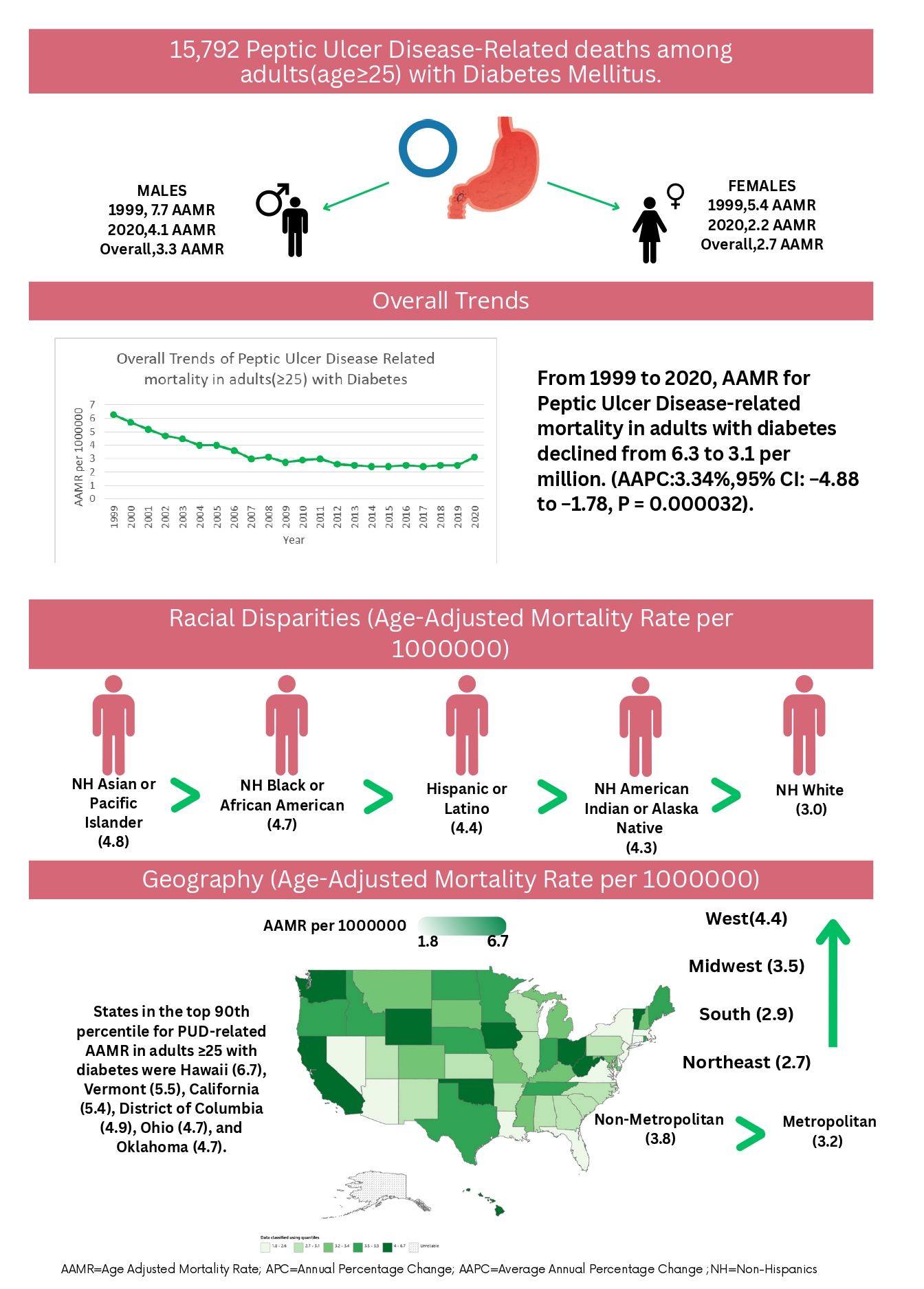Tuesday Poster Session
Category: GI Bleeding
P5220 - Trends in Peptic Ulcer Disease–Related Mortality Among Adults Aged ≥25 With Diabetes in the United States: A Retrospective Population-Based Analysis (1999–2020)
Tuesday, October 28, 2025
10:30 AM - 4:00 PM PDT
Location: Exhibit Hall

Ibrar Atiq, MD
United Health Services, Wilson Medical Center
Johnson City, NY
Presenting Author(s)
Ibrar Atiq, MD1, Usman Mazhar, MBBS2, Maliha Khalid, MBBS3, Hafsah Ali, MBBS4, Daniyal Abbasi, MBBS5, Ali Hamza, MBBS6, Muhammad Hamza Rafique, MD7, Maham Waqar, MBBS8, Allah Dad, MD9, Fnu Veena, MD10, Abdul Subhan Talpur, MD1, Fawad Talat, MD1, Azeem Khalid, MD11, Ahmed Shehadah, MD12
1United Health Services, Wilson Medical Center, Johnson City, NY; 2Rawalpindi Medical University, Pakistan, Rawalpindi, Punjab, Pakistan; 3Jinnah Sindh Medical University, Karachi, Sindh, Pakistan; 4Allama Iqbal Medical College, Manama, Al Muharraq, Bahrain; 5Islamabad Medical and Dental College, Islamabad, Islamabad, Pakistan; 6Army Medical College, Rawalpindi, Punjab, Pakistan; 7Woodhull Medical Center, Brooklyn, NY; 8Rawalpindi Medical University, Rawalpindi, Punjab, Pakistan; 9Shiekh Zayed Medical College Rahim Yar Khan, Pakistan, Kot Addu, Punjab, Pakistan; 10BronxCare Health System, Bronx, NY; 11Aiken Regional Medical Centers, Aiken, SC; 12United Health Services, Wilson Medical Center, Binghamton, NY
Introduction: Diabetes mellitus impairs ulcer healing through microvascular damage, immune dysfunction, and delayed gastric motility, increasing the risk of adverse peptic ulcer disease (PUD) outcomes. Monitoring mortality in this high-risk group is essential to guide prevention strategies. This study examined national trends in PUD-related mortality among U.S. adults aged ≥25 with diabetes from 1999 to 2020, focusing on temporal, demographic, and geographic patterns.
Methods: We analyzed CDC WONDER data (1999–2020) for PUD-related deaths in adults ≥25 with diabetes mellitus (ICD-10: E10–E14, K25–K28). Age-adjusted mortality rates (AAMRs) per 1,000,000 population were calculated. Joinpoint regression was used to evaluate Annual percent changes (APCs). Data were stratified by sex, race/ethnicity, age, state, region, and 2013 urbanization level.
Results: From 1999 to 2020, AAMR for PUD-related mortality in adults with diabetes declined from 6.3 to 3.1 per million (APC: 3.34%, CI: −4.88 to −1.78, P = 0.000032) with 15,792 deaths recorded. Males had higher AAMRs (4.1) than females (2.7). Mortality declined significantly in middle-aged adults until 2015 and in older adults until 2018. After 2015, mortality in middle-aged adults increased significantly (APC: 6.61%, p = 0.004), while no significant rise was observed in older adults, with overall APC decline in both groups.
By race/ethnicity, the highest AAMRs were seen in non-Hispanic (NH) Asian or Pacific islanders (4.8), NH Blacks (4.7), Hispanics (4.4), NH American Indian/Alaska Natives (4.3) and NH Whites (3) populations. In Hispanics, a significant rise in mortality was observed from 2015 to 2020 (APC: +10.45%, CI: 1.20–20.53, p < 0.05), a pattern not observed in other racial groups. AAMR declined across all regions. The highest AAMR was observed in West (4.4), followed by Midwest (3.5), South (2.9) and Northeast (2.7). Metropolitan areas showed a significant rise in mortality from 2016 to 2020 (APC: 6.35%, CI: 1.40-11.55, p = 0.015).
Discussion: Although PUD-related mortality in adults with diabetes declined overall between 1999 and 2020, recent rise among middle-aged adults, Hispanics, and metropolitan areas since 2015 is concerning. These patterns may reflect delayed diagnosis, higher comorbidity burden, and increased use of gastrotoxic drugs. Addressing this reversal will require integrating gastrointestinal risk assessment into routine diabetic care, improving urban healthcare access, and tailoring public health outreach for high-risk populations

Figure: Figure 1: Trends in Peptic Ulcer Disease–Related Mortality Among Adults Aged ≥25 With Diabetes in the United States: A Retrospective Population-Based Analysis (1999–2020)
Disclosures:
Ibrar Atiq indicated no relevant financial relationships.
Usman Mazhar indicated no relevant financial relationships.
Maliha Khalid indicated no relevant financial relationships.
Hafsah Ali indicated no relevant financial relationships.
Daniyal Abbasi indicated no relevant financial relationships.
Ali Hamza indicated no relevant financial relationships.
Muhammad Hamza Rafique indicated no relevant financial relationships.
Maham Waqar indicated no relevant financial relationships.
Allah Dad indicated no relevant financial relationships.
Fnu Veena indicated no relevant financial relationships.
Abdul Subhan Talpur indicated no relevant financial relationships.
Fawad Talat indicated no relevant financial relationships.
Azeem Khalid indicated no relevant financial relationships.
Ahmed Shehadah indicated no relevant financial relationships.
Ibrar Atiq, MD1, Usman Mazhar, MBBS2, Maliha Khalid, MBBS3, Hafsah Ali, MBBS4, Daniyal Abbasi, MBBS5, Ali Hamza, MBBS6, Muhammad Hamza Rafique, MD7, Maham Waqar, MBBS8, Allah Dad, MD9, Fnu Veena, MD10, Abdul Subhan Talpur, MD1, Fawad Talat, MD1, Azeem Khalid, MD11, Ahmed Shehadah, MD12. P5220 - Trends in Peptic Ulcer Disease–Related Mortality Among Adults Aged ≥25 With Diabetes in the United States: A Retrospective Population-Based Analysis (1999–2020), ACG 2025 Annual Scientific Meeting Abstracts. Phoenix, AZ: American College of Gastroenterology.
1United Health Services, Wilson Medical Center, Johnson City, NY; 2Rawalpindi Medical University, Pakistan, Rawalpindi, Punjab, Pakistan; 3Jinnah Sindh Medical University, Karachi, Sindh, Pakistan; 4Allama Iqbal Medical College, Manama, Al Muharraq, Bahrain; 5Islamabad Medical and Dental College, Islamabad, Islamabad, Pakistan; 6Army Medical College, Rawalpindi, Punjab, Pakistan; 7Woodhull Medical Center, Brooklyn, NY; 8Rawalpindi Medical University, Rawalpindi, Punjab, Pakistan; 9Shiekh Zayed Medical College Rahim Yar Khan, Pakistan, Kot Addu, Punjab, Pakistan; 10BronxCare Health System, Bronx, NY; 11Aiken Regional Medical Centers, Aiken, SC; 12United Health Services, Wilson Medical Center, Binghamton, NY
Introduction: Diabetes mellitus impairs ulcer healing through microvascular damage, immune dysfunction, and delayed gastric motility, increasing the risk of adverse peptic ulcer disease (PUD) outcomes. Monitoring mortality in this high-risk group is essential to guide prevention strategies. This study examined national trends in PUD-related mortality among U.S. adults aged ≥25 with diabetes from 1999 to 2020, focusing on temporal, demographic, and geographic patterns.
Methods: We analyzed CDC WONDER data (1999–2020) for PUD-related deaths in adults ≥25 with diabetes mellitus (ICD-10: E10–E14, K25–K28). Age-adjusted mortality rates (AAMRs) per 1,000,000 population were calculated. Joinpoint regression was used to evaluate Annual percent changes (APCs). Data were stratified by sex, race/ethnicity, age, state, region, and 2013 urbanization level.
Results: From 1999 to 2020, AAMR for PUD-related mortality in adults with diabetes declined from 6.3 to 3.1 per million (APC: 3.34%, CI: −4.88 to −1.78, P = 0.000032) with 15,792 deaths recorded. Males had higher AAMRs (4.1) than females (2.7). Mortality declined significantly in middle-aged adults until 2015 and in older adults until 2018. After 2015, mortality in middle-aged adults increased significantly (APC: 6.61%, p = 0.004), while no significant rise was observed in older adults, with overall APC decline in both groups.
By race/ethnicity, the highest AAMRs were seen in non-Hispanic (NH) Asian or Pacific islanders (4.8), NH Blacks (4.7), Hispanics (4.4), NH American Indian/Alaska Natives (4.3) and NH Whites (3) populations. In Hispanics, a significant rise in mortality was observed from 2015 to 2020 (APC: +10.45%, CI: 1.20–20.53, p < 0.05), a pattern not observed in other racial groups. AAMR declined across all regions. The highest AAMR was observed in West (4.4), followed by Midwest (3.5), South (2.9) and Northeast (2.7). Metropolitan areas showed a significant rise in mortality from 2016 to 2020 (APC: 6.35%, CI: 1.40-11.55, p = 0.015).
Discussion: Although PUD-related mortality in adults with diabetes declined overall between 1999 and 2020, recent rise among middle-aged adults, Hispanics, and metropolitan areas since 2015 is concerning. These patterns may reflect delayed diagnosis, higher comorbidity burden, and increased use of gastrotoxic drugs. Addressing this reversal will require integrating gastrointestinal risk assessment into routine diabetic care, improving urban healthcare access, and tailoring public health outreach for high-risk populations

Figure: Figure 1: Trends in Peptic Ulcer Disease–Related Mortality Among Adults Aged ≥25 With Diabetes in the United States: A Retrospective Population-Based Analysis (1999–2020)
Disclosures:
Ibrar Atiq indicated no relevant financial relationships.
Usman Mazhar indicated no relevant financial relationships.
Maliha Khalid indicated no relevant financial relationships.
Hafsah Ali indicated no relevant financial relationships.
Daniyal Abbasi indicated no relevant financial relationships.
Ali Hamza indicated no relevant financial relationships.
Muhammad Hamza Rafique indicated no relevant financial relationships.
Maham Waqar indicated no relevant financial relationships.
Allah Dad indicated no relevant financial relationships.
Fnu Veena indicated no relevant financial relationships.
Abdul Subhan Talpur indicated no relevant financial relationships.
Fawad Talat indicated no relevant financial relationships.
Azeem Khalid indicated no relevant financial relationships.
Ahmed Shehadah indicated no relevant financial relationships.
Ibrar Atiq, MD1, Usman Mazhar, MBBS2, Maliha Khalid, MBBS3, Hafsah Ali, MBBS4, Daniyal Abbasi, MBBS5, Ali Hamza, MBBS6, Muhammad Hamza Rafique, MD7, Maham Waqar, MBBS8, Allah Dad, MD9, Fnu Veena, MD10, Abdul Subhan Talpur, MD1, Fawad Talat, MD1, Azeem Khalid, MD11, Ahmed Shehadah, MD12. P5220 - Trends in Peptic Ulcer Disease–Related Mortality Among Adults Aged ≥25 With Diabetes in the United States: A Retrospective Population-Based Analysis (1999–2020), ACG 2025 Annual Scientific Meeting Abstracts. Phoenix, AZ: American College of Gastroenterology.
